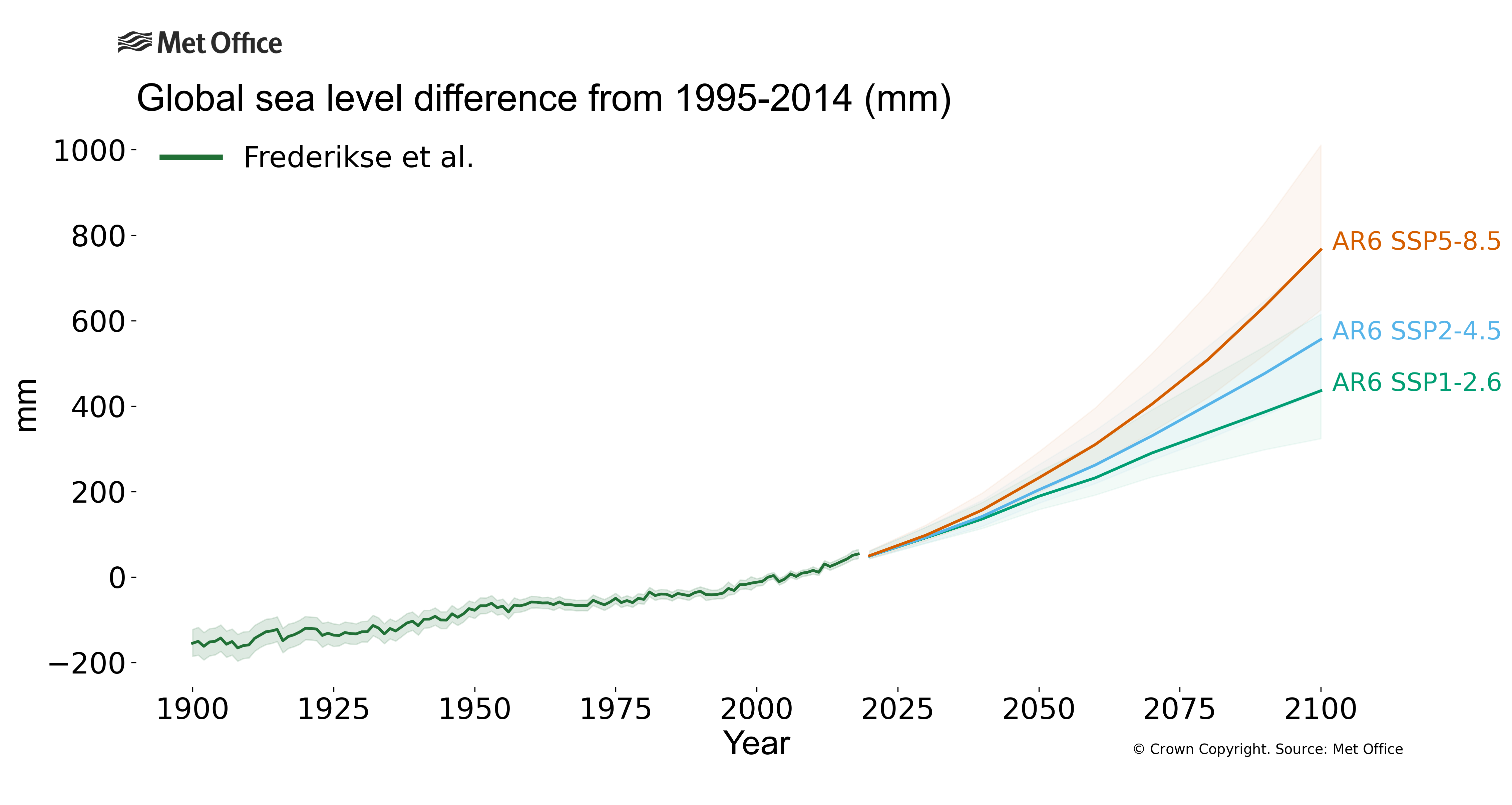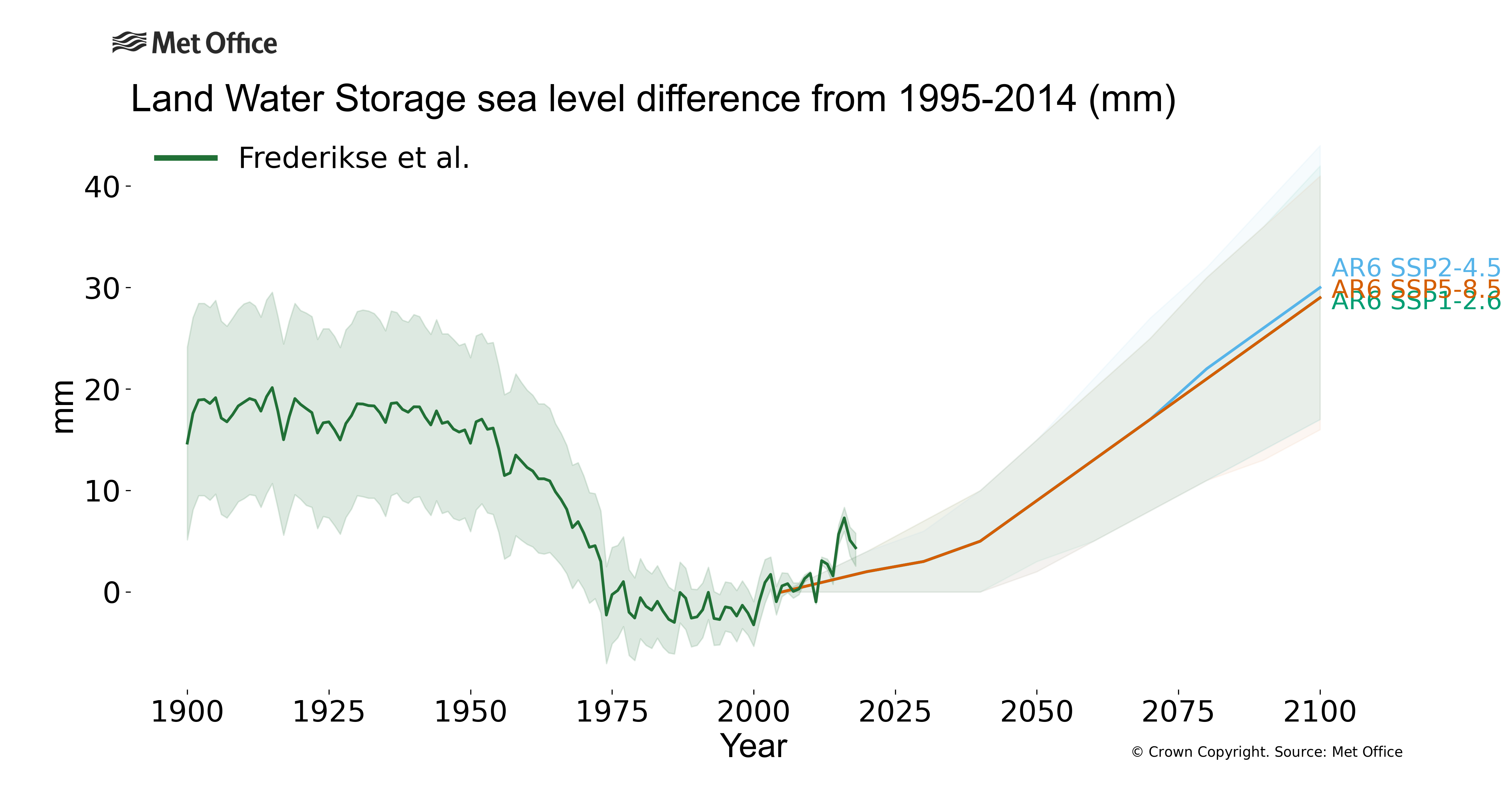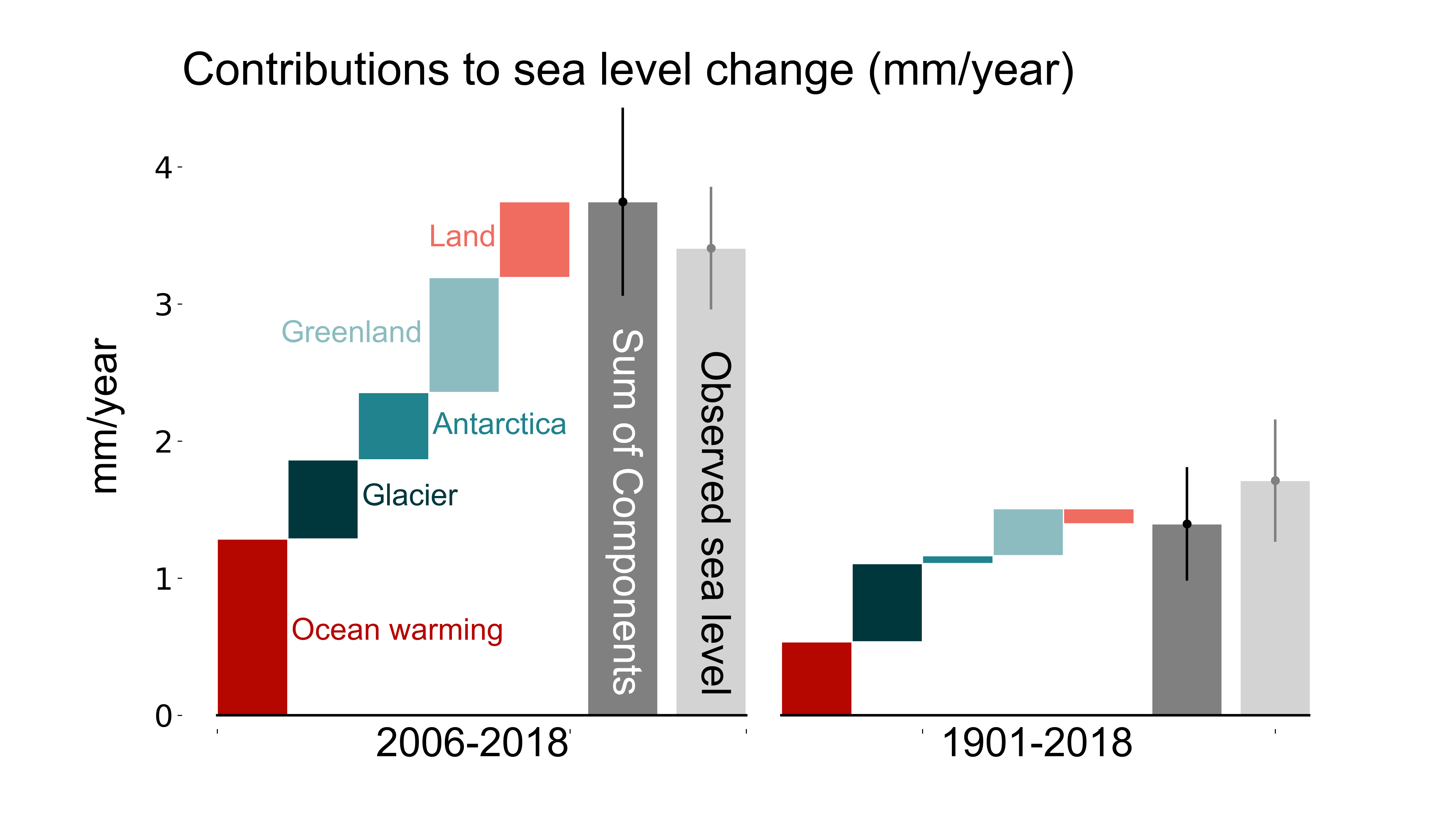Why is Land Water Storage important for understanding sea level change?
Water on land is important for the climate system as it sums multiple components, including soil moisture and water stored in vegetation, which affect plant life, as well as water channelled, retained, and removed by human activities, such as rivers, reservoirs, and groundwater. Land water storage saw a peak in the 1970s which was sufficient to slow down the global mean sea level rise in that period. Although land water storage is a small component of the sea level budget, it is important for ensuring that this budget ‘closes’, meaning that, within uncertainties, the sum of the contributors to sea level matches the observed sea level rise.
How has the amount of water stored on land changed?
Land Water Storage varied over the 20th century but is now contributing to rising sea levels. The most notable feature in the land water storage time series is the drop in sea level contribution in the 1970s. This was caused by increased reservoir building, thus retaining more water on land. Estimates of past land water storage come with large uncertainties, and there aren’t uniform uncertainties across the different components of land water storage. For this reason, the IPCC considers the contribution of Land Water Storage to sea level change as low confidence.
Why has Land Water Storage changed?
The IPCC states that changes in land water storage can be caused by human influence e.g., as a result of the building of reservoirs, extracting groundwater or deforestation, but that climate variations e.g., changes in the amounts of water in lakes and permafrost are also contributors. However, they do note that these climate variations can also be indirectly affected by human influence.
How is Land Water Storage projected to change?
Future land water storage is uncertain, but it is projected to have a small positive contribution to global mean sea levels over the coming century. The contribution will be smaller if all the dams currently planned are built, as these have a lowering effect on global mean sea level, while groundwater extraction makes a positive contribution to global mean sea level as the majority of groundwater extracted for use will eventually end up in the oceans.
How is Terrestrial Water Storage measured?
The Land Water Storage observations come from Frederikse et al., 2020 which sums a number of different components: the natural component, a water impoundment component, and a groundwater depletion component.
The natural component is obtained using a statistical model trained on GRACE satellite data and inputs from observational and reanalysis datasets ( Humphrey and Gudmundsson, 2019).
The rate of water impoundment in reservoirs is obtained from Chao et al., 2008 which itself takes data from the International Commission on Large Dams (ICOLDs). In their estimates Chao et al., account for small reservoirs, water seepage from reservoirs, and the fact that reservoirs will not always be filled to capacity. Frederikse et al., take these same considerations into account.
Groundwater depletion estimates for Frederikse et al., come from the GRACE satellite observations, hydrological models and well observations ( Wada et al. 2012, Döll et al., 2014). Their estimates also take into account the findings of Wada et al., 2016 who show that not all extracted groundwater will accumulate in the oceans e.g., some will be used for irrigation and return to being groundwater.
How are Land Water Storage projections made?
Land water storage projections are determined based on the known relationships between population size and groundwater depletion and population size and impoundment of water using dams. These projections are therefore more linear than the projections of other components and vary little by scenario. The projected relationship up to 2040 is adjusted for recent estimates of dam construction. Climate variability is not included in land water storage projections as its future changes are either not well quantified or are considered negligible.
Find out more?
References
AR6 Projections
- Information source: Fox-Kemper, B., H. T. Hewitt, C. Xiao, G. Aðalgeirsdóttir, S. S. Drijfhout, T. L. Edwards, N. R. Golledge, M. Hemer, R. E. Kopp, G. Krinner, A. Mix, D. Notz, S. Nowicki, I. S. Nurhati, L. Ruiz, J-B. Sallée, A. B. A. Slangen, Y. Yu, 2021, Ocean, Cryosphere and Sea Level Change. In: Climate Change 2021: The Physical Science Basis. Contribution of Working Group I to the Sixth Assessment Report of the Intergovernmental Panel on Climate Change [Masson-Delmotte, V., P. Zhai, A. Pirani, S. L. Connors, C. Péan, S. Berger, N. Caud, Y. Chen, L. Goldfarb, M. I. Gomis, M. Huang, K. Leitzell, E. Lonnoy, J. B. R. Matthews, T. K. Maycock, T. Waterfield, O. Yelekçi, R. Yu and B. Zhou (eds.)]. Cambridge University Press. In press.
- Information source: Garner, G. G., R. E. Kopp, T. Hermans, A. B. A. Slangen, G. Koubbe, M. Turilli, S. Jha, T. L. Edwards, A. Levermann, S. Nowikci, M. D. Palmer, C. Smith, in prep. Framework for Assessing Changes To Sea-level (FACTS). Geoscientific Model Development.
- Information source: Garner, G. G., T. Hermans, R. E. Kopp, A. B. A. Slangen, T. L. Edwards, A. Levermann, S. Nowikci, M. D. Palmer, C. Smith, B. Fox-Kemper, H. T. Hewitt, C. Xiao, G. Aðalgeirsdóttir, S. S. Drijfhout, T. L. Edwards, N. R. Golledge, M. Hemer, R. E. Kopp, G. Krinner, A. Mix, D. Notz, S. Nowicki, I. S. Nurhati, L. Ruiz, J-B. Sallée, Y. Yu, L. Hua, T. Palmer, B. Pearson, 2021. IPCC AR6 Sea-Level Rise Projections. Version 20210809. PO.DAAC, CA, USA. Dataset accessed [YYYY-MM-DD] at https://podaac.jpl.nasa.gov/announcements/2021-08-09-Sea-level-projections-from-the-IPCC-6th-Assessment-Report.
- Information reference: We thank the projection authors for developing and making the sea-level rise projections available, multiple funding agencies for supporting the development of the projections, and the NASA Sea-Level Change Team for developing and hosting the IPCC AR6 Sea-Level Projection Tool. We also acknowledge the World Climate Research Programme, which, through its Working Group on Coupled Modelling, coordinated and promoted CMIP6. We thank the climate modeling groups for producing and making available their model output, the Earth System Grid Federation (ESGF) for archiving the data and providing access, and the multiple funding agencies who support CMIP6 and ESGF.
Terrestrial Water Storage
AR6 SSP1-2.6
AR6 SSP2-4.5
AR6 SSP5-8.5
Frederikse et al.
- Information source: Frederikse, T., Landerer, F., Caron, L. et al. The causes of sea-level rise since 1900. Nature 584, 393–397 (2020). https://doi.org/10.1038/s41586-020-2591-3
- Information reference: Thomas Frederikse, Felix Landerer, Lambert Caron, Surendra Adhikari, David Parkes, Vincent W. Humphrey... Yun-Hao Wu. (2020). data supplement of 'The causes of sea-level rise since 1900' [Data set]. Zenodo. http://doi.org/10.5281/zenodo.3862995


